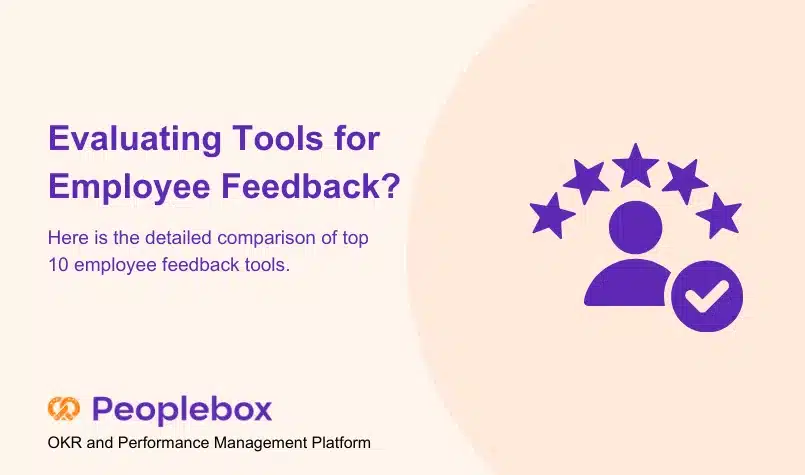TL;DR
360-degree reviews give feedback from managers, peers, direct reports, and even customers offering a full picture of performance. They boost self-awareness, reduce bias, improve team dynamics, and help plan growth.
Challenges include complexity, politics, and confidentiality concerns. Done right, especially with tools like Peoplebox.ai, 360 reviews can turn feedback into real, actionable growth.
Are your team’s performance reviews not helping your business grow? It can be annoying when feedback doesn’t lead to actual progress. What if one easy change could seriously improve things? That change is 360-degree feedback.
Companies that use these reviews have seen employee engagement jump by as much as 20%. As work changes, many companies are using this way to get feedback from different people. This helps workers do better and the company grows.
360-degree reviews are becoming a key part of managing performance. Unlike normal reviews that just look at what managers say, this way gets info from bosses, teammates, people who report to the employee, and even customers sometimes. This gives a clearer idea of how someone is doing.
Today, teamwork, emotional IQ, and people skills are more important than before. 360 reviews find these things in ways that old reviews don’t. But, like anything, there are good and bad sides that companies should think about.
What Exactly Are 360-Degree Reviews?
360-degree reviews are ways to check employee performance where info is gathered from many people who work with that employee. Unlike old-style reviews where only a supervisor gives input, 360 reviews collect thoughts from:
- Supervisors and managers: They watch over the employee’s work.
- Peers and coworkers: They work with the employee often.
- Direct reports: These people work for the employee.
- Internal customers: These are people from other parts of the company who work with the employee.
- External people: This could be clients or vendors, when it makes sense.
- The employee themselves: They also give their own thoughts.
The term 360-degree means that the review gives a full, all-around view of how well an employee is doing, what skills they have, and how they act at work. The goal is to get a more complete and correct idea of how someone helps the company.
Usually, this is done with questionnaires that ask about certain skills, actions, and areas of performance that matter to the employee’s job and the company’s aims. The feedback that is collected is then put together, looked at, and given to the employee and their manager. It helps them talk about how to grow and plan for better performance.
What are the Pros and Cons of 360 reviews
360 reviews offer valuable insights but come with their own set of challenges. Here’s a breakdown of the key benefits and drawbacks:
| Pros | Cons |
| Comprehensive Feedback: Provides a holistic view of performance from multiple sources. | Complexity: The process is time-consuming and requires significant administrative effort. |
| Enhanced Self-Awareness: Identifies blind spots and areas for personal growth. | Bias and Politics: Can be affected by personal relationships or workplace politics. |
| Reduced Bias: Increases objectivity by gathering feedback from diverse perspectives. | Confidentiality Concerns: Employees may worry about the anonymity of their feedback. |
| Targeted Development: Helps identify skill gaps and create personalized development plans. | Information Overload: Large volumes of feedback can overwhelm employees and managers. |
| Improved Team Dynamics: Enhances communication and collaboration within teams. | Misuse: Can be misapplied for salary or promotion decisions, undermining its developmental purpose. |
| Leadership Development: Offers valuable insights for identifying leadership potential. | Cultural Resistance: Some organizations may struggle with the openness required for 360 reviews. |
Here’s a closer look at these pros and cons of 360 reviews.
The Advantages of 360-Degree Reviews
When feedback comes from every angle, you see the whole story not just a single chapter.
1. Comprehensive Performance Picture
360 reviews give a full view of how well an employee is doing because they get input from different people who work with that person in different ways. This complete method shows patterns of performance that might be missed by only getting info from one source.
For instance, someone might be fantastic at handling clients but struggle a bit when it comes to collaborating with their own team. If only their manager is giving feedback, those nuances can slip through the cracks.
With 360° feedback, you get input from everyone they work with. This way, you see the whole picture of how they do in different situations and with various people.
2. Enhanced Self-Awareness
One of the best things about 360 reviews is that they can show where what you think about your performance doesn’t match what others think. Closing this gap in understanding is key for getting better at your job.
Often, employees find out about weak spots in how they act or perform that they didn’t even know about. They also get credit for strong points that they didn’t realize they had. This improved self-understanding becomes the base for trying to grow in specific ways.
360 feedback particularly helps to grow emotional intelligence by giving understanding into how your actions hit others. Knowing these impacts is important for growing leadership skills and having good relationships at work.
3. Reduced Bias and Increased Objectivity
By getting feedback from many sources, 360 reviews help lower the amount of personal bias that can impact reviews from only one person. When many people give similar feedback about certain actions or performance areas, it makes the review more believable and fair.
This method from many sources helps even out views that might be uneven. If one person doing the review has a very good or bad view, feedback from others gives background and balances the overall review.
4. Improved Employee Development
360 reviews provide a lot of info for making custom growth plans. With feedback from different sources, companies can find certain areas where employees need help and plan learning activities that target those areas.
The full nature of 360 feedback helps find skill gaps that might not be clear in day-to-day work. This allows for better planning on growing the workforce strategically.
360 reviews are very helpful for growing leadership skills. They give ideas on how well managers are doing, how good their communication skills are, and how much they impact the team. These are all key things for leaders to have.
5. Enhanced Team Dynamics and Communication
The process of 360 reviews often makes communication and relationships better within teams. If done right, it makes chances for talking honestly about performance and working together.
Knowing that feedback will come from many sources makes employees think about how they hit all those around them, not just their boss. This wider responsibility can make workplace actions and performance better overall.
6. Better Succession Planning and Talent Management
360 reviews give helpful info for planning who will take over leadership roles by showing how possible leaders are seen by different levels of the company. This idea is important for making smart choices about who to promote.
Feedback from many sources helps find employees who do well consistently with different people and in different situations. This makes them strong choices for chances to move up.
7. Organizational Culture Development
360 reviews can be made to support certain company values and wanted actions by asking questions that focus on fitting in with the culture and showing those values.
Using 360 reviews often helps make giving feedback a normal thing in the company, which makes a culture that is more open and focused on growth.

The Disadvantages and Challenges of 360-Degree Reviews
While 360 feedback can be a powerful growth tool, it’s not without its speed bumps and knowing them can make the difference between a helpful process and a frustrating one.
1. Complexity and Administrative Burden
360 reviews take much more time and resources than old-style performance reviews. Getting feedback from many sources, making sure people take part, and handling the data collection can be hard without good systems.
Doing 360 reviews well needs strong technology platforms to handle the complexity of getting feedback from many sources, keeping it secret, and giving useful data.
2. Potential for Bias and Politics
Even with many views, 360 reviews can still be impacted by office politics, personal relationships, and how the company works. Workers might give good reviews to keep relationships or bad reviews because of disagreements.
Different people doing the review might use different rules when judging performance. This can lead to feedback that doesn’t match and is hard to understand and act on.
Sometimes, people doing the review might use the secrecy of 360 reviews to get back at others or show frustrations that have nothing to do with how well they are doing at their job.
3. Confidentiality and Trust Issues
Even though 360 reviews are meant to be anonymous, people can still worry about privacy especially in smaller teams where it’s easier to guess who said what. That worry can make feedback less open and honest, or even make some people avoid participating altogether.
If 360 reviews are done badly or if privacy is broken, it can hurt trust within teams and make future feedback efforts less helpful.
4. Overwhelming Feedback Volume
360 reviews can make a lot of feedback that might be hard for workers to deal with and decide what is most important. Without good guidance, workers might feel weighed down instead of helped by the feedback.
Sometimes, different people doing the review give feedback that doesn’t match about the same actions or performance areas. This causes confusion about what actions to take to get better.
5. Misuse and Inappropriate Application
360 reviews are mainly for helping people grow, but sometimes companies use them wrongly for salary, promotion, or firing decisions. This wrong use can hurt the process and make people not want to take part honestly.
Getting 360 feedback without planning for action and support makes the process not helpful and can frustrate people who expect their input to lead to real change.
6. Cultural and Organizational Challenges
360 reviews might not be right for all company cultures, especially those with strong boss-employee structures or cultures where direct feedback is not supported.
Some workers and managers might not like the 360 review process, seeing it as a threat or not needed, which can make it less helpful.
7. Quality and Reliability Concerns
Not all people doing the review have the skills or experience needed to give good feedback. People might not have the view to judge certain skills, while those who report to them might feel uneasy rating their bosses.
People doing the review might tend to rate everything as average to avoid trouble or rate everything positively to avoid hard talks.
Best Practices for Implementing 360 Reviews
Running 360 reviews well isn’t just about sending out surveys, it’s about setting the stage so feedback turns into real, lasting growth.
1. Clear Purpose and Communication
Clearly say the point of 360 reviews whether it’s for growth, performance judging, or both. Make sure all people taking part understand how the feedback will be used and what results to expect.
Give clear rules about the review process, timeline, privacy steps, and how results will be shared and acted on.
2. Proper Training and Support
Train all people taking part on how to give feedback that is helpful, specific, and easy to act on. This includes guidance on avoiding bias and focusing on actions that can be seen rather than personality traits.
Make sure managers are ready to lead good talks about 360 feedback results and help workers make growth plans based on the ideas.
3. Technology and Process Design
Pick a technology platform that can handle the complexity of 360 reviews while keeping things private and giving useful data.
Design a smooth process that lowers work while making sure thorough feedback is collected and looked at.
4. Follow-up and Action Planning
Use 360 feedback as the base for making specific, measurable growth plans with clear goals and timelines.
Give continued support and resources to help workers act on their 360 feedback and watch progress over time.
360 Reviews in the Modern Workplace
As the workplace evolves, so does the way we gather, interpret, and act on feedback and 360 reviews are adapting right alongside these changes.
Remote and Hybrid Work Considerations
With more remote and mixed work ways of doing things, 360 reviews become even more helpful for understanding how workers do in different work settings. The companies have to change their ways to make sure complete feedback is collected when team members work mainly through digital ways.
Integration with Continuous Feedback
Modern companies are moving toward constant feedback models rather than once a year review times. 360 reviews can be added into these ongoing feedback systems, giving regular full checks that add to regular check-ins and real-time feedback.
AI and Analytics Enhancement
Advanced data and AI can make 360 reviews better by finding patterns in feedback, suggesting growth priorities, and even sensing possible bias in review answers. These technologies make 360 reviews easier to act on and fair.
Making the Decision: Are 360 Reviews Right for Your Organization?
Deciding whether to introduce 360 reviews isn’t just about the tool itself, it’s about whether your culture, resources, and goals are ready to make it truly effective.
| Consider Implementing 360 Reviews | Avoid or Delay 360 Reviews |
| Values complete worker growth | Doesn’t have the technology structure to handle the process well |
| Has a culture that supports open feedback | Has big trust problems or bad workplace dynamics |
| Needs better understanding into leadership help | Can’t commit to good training and follow-up support |
| Wants to make team working and talking better | Plans to use the feedback mainly for negative reasons |
| Has the resources to do and support the process well | Has a culture that strongly doesn’t like direct feedback |
| Is committed to acting on feedback results |
How to Make 360 Performance Reviews Work with Peoplebox.ai
To do a good 360 performance review, you need the right tools and a simple process, and that’s where Peoplebox.ai can assist. Designed for big companies, it puts goals, feedback, coaching, and reviews all in one platform that’s easy to handle.
Peoplebox.ai makes the whole review process simpler for employees and managers. Here’s how to get the most out of its features for a 360 review that makes a difference:
Do Performance Reviews in Slack: No need for lots of different tools do the whole review in Slack. It’s easy, handy, and keeps everything where your team is already working.
Link OKRs/KPIs to performance reviews: This way, employee goals are clearly related to company results. Peoplebox.ai lets you change how OKRs affect review standards for a more useful process.
All-in-One Goal-Setting and Tracking: Handle goal-setting, KPIs, and projects in one spot. Up-to-date info makes sure everyone can see what’s happening and stays on the same page during the review.
Automatic Reminders: Get reminders on Slack or by email so everyone knows what’s happening during the review.
See the Whole Review Process in Real-Time: Keep an eye on how the review is going. Peoplebox.ai has a dashboard that shows timelines, submissions, and feedback quickly.
Using Peoplebox.ai’s smart features, you can do 360 reviews that are on time, organized, and focused on growth. The platform is easy to use and has workflows that make it simpler to give, get, and use feedback.
Ready to unlock your team’s full potential? Implement 360 reviews today with PeopleBox.ai and experience the transformation.
Frequently Asked Questions
How often should organizations conduct 360 reviews?
Most organizations conduct 360 reviews annually or bi-annually for comprehensive assessments, with some implementing quarterly mini-360s for specific competencies. The frequency should align with your development cycle and organizational capacity to act on feedback.
How often should organizations conduct 360 reviews?
Most organizations conduct 360 reviews annually or bi-annually for comprehensive assessments, with some implementing quarterly mini-360s for specific competencies. The frequency should align with your development cycle and organizational capacity to act on feedback.
Should 360 reviews be used for compensation and promotion decisions?
360 reviews are primarily designed for development purposes. While they can provide valuable input for promotion decisions, they should not be the sole factor in compensation or advancement choices due to potential bias and the developmental nature of the feedback.
How many reviewers should participate in a 360 review?
Typically, 5-8 reviewers provide sufficient perspective while remaining manageable. This usually includes 1-2 supervisors, 3-4 peers, 2-3 direct reports (if applicable), and sometimes internal or external customers.
What if employees receive contradictory feedback in their 360 review?
Contradictory feedback is common and can be valuable for understanding how behavior impacts different stakeholders. The key is working with managers or coaches to identify patterns, understand context, and prioritize development areas based on role requirements and career goals.
How can organizations ensure honest feedback in 360 reviews?
Ensure confidentiality, provide clear guidelines on constructive feedback, train reviewers on bias awareness, communicate the developmental purpose clearly, and demonstrate commitment to acting on feedback through visible development support and resources.






